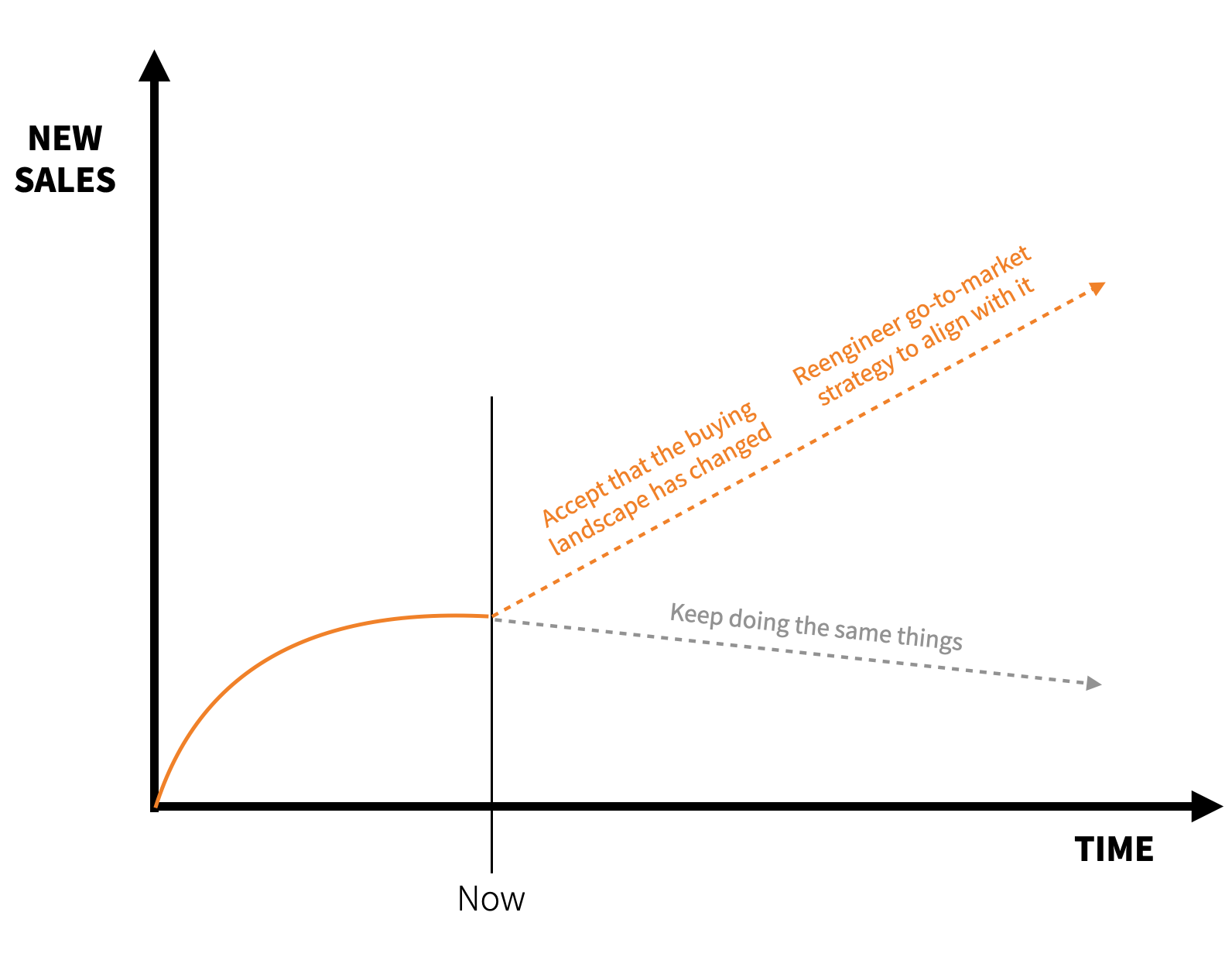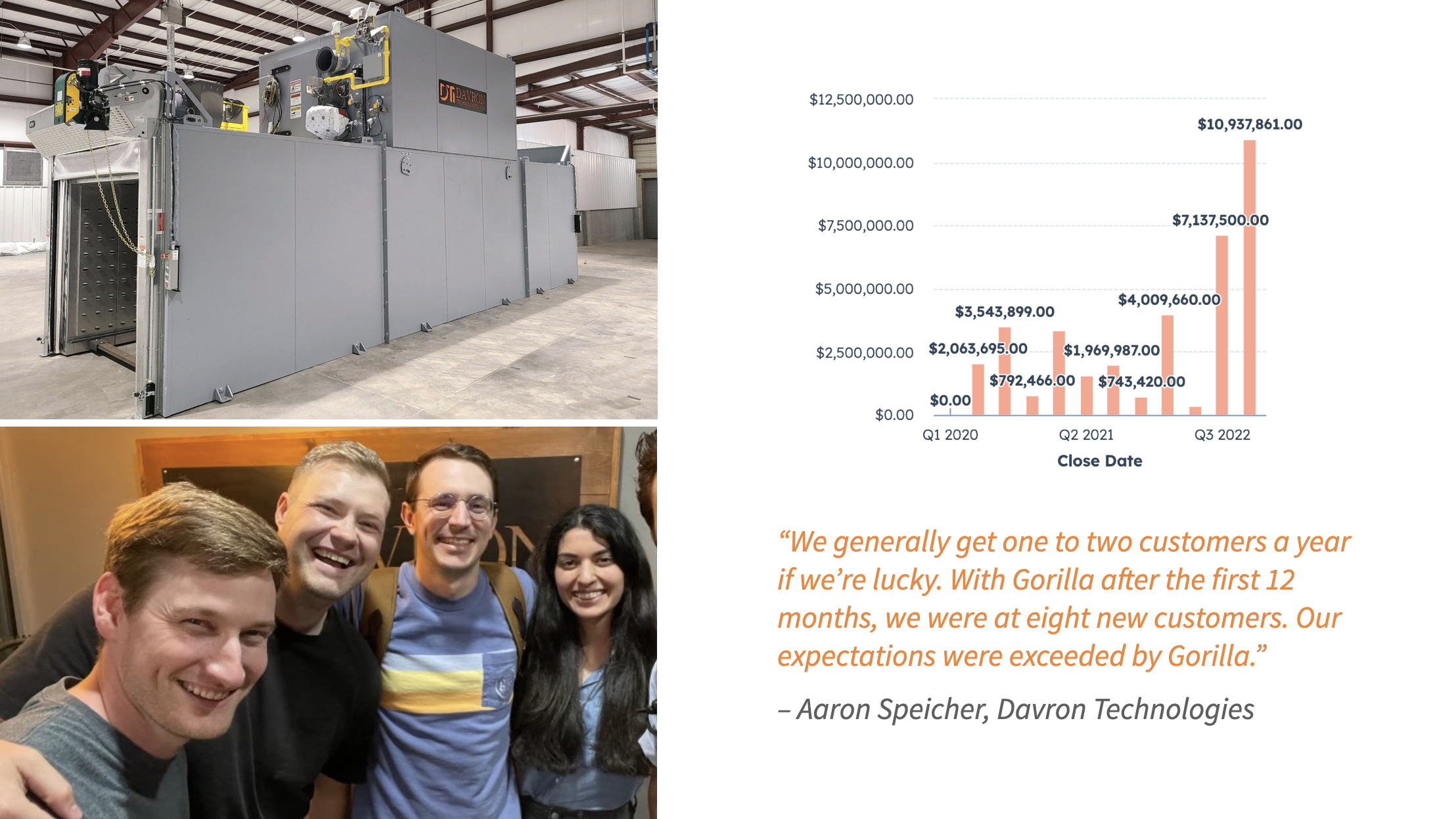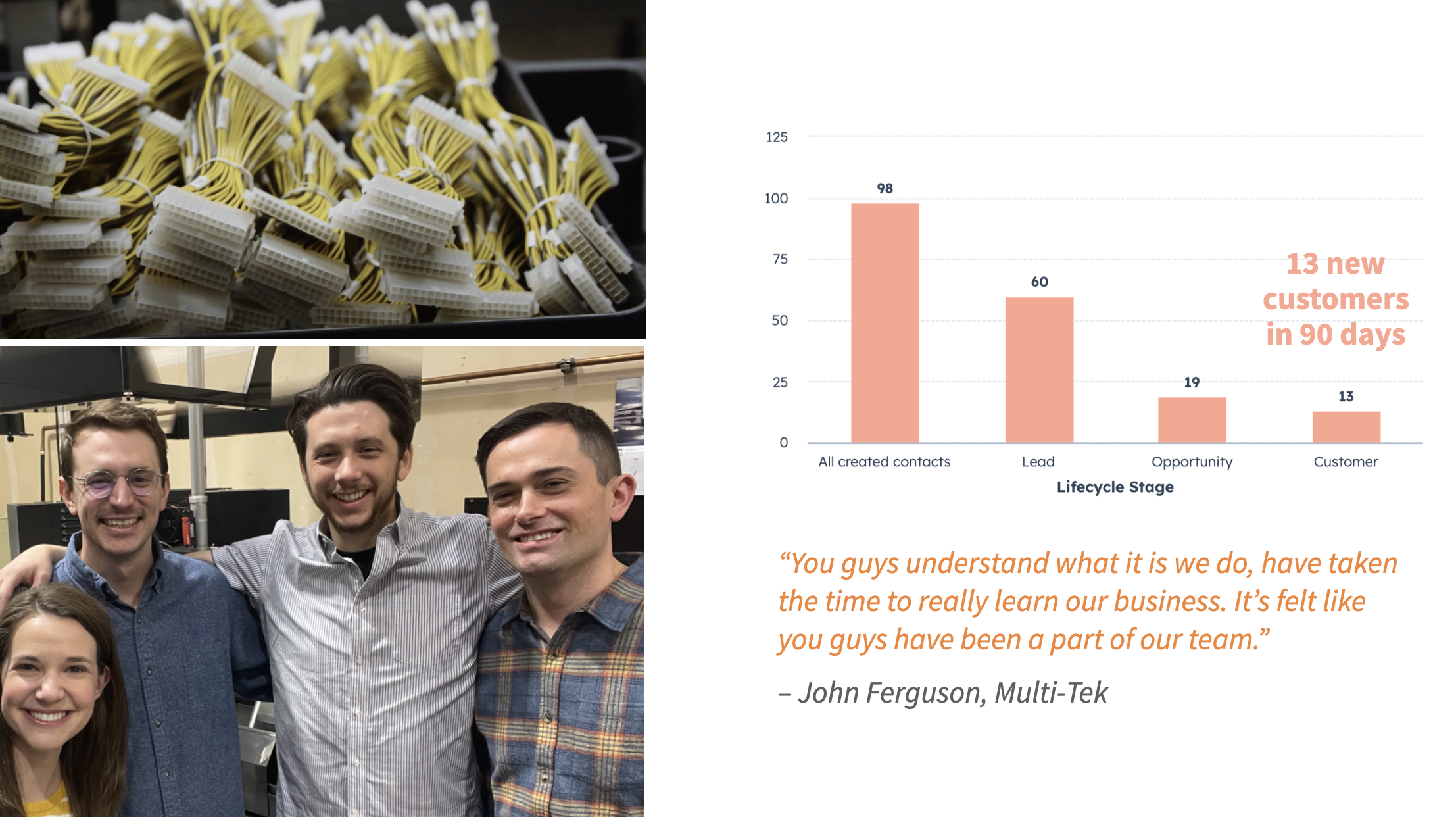The buying landscape has changed in B2B manufacturing
These four photos represent the ways most manufacturers have approached new sales development over the past decade (or in the cases of images A, B and C, since the beginning of time!):

- Image A: The Three Rs (relationships, referrals and repeat business)
- Image B: Trade shows
- Image C: Calling on prospects and past customers (phone, email, knocking on doors, etc)
- Image D: Getting discovered through Google searches
First of all, kudos to those of you who have successfully built your companies on the backs of these go-to-market methods. Your success to date is a testament to the fact that you have something your audience needs and you’ve figured out how to construct a profitable business around it.
That’s no small feat.
But as someone who has advised well over 200 B2B manufacturing leaders, here’s my warning as I look down the road:
For many of these companies, what got them where they are today won’t get them where they want to go in the years ahead.
I’ll use each of the four images above to illustrate why.
The Three Rs (relationships, referrals and repeat business)

As of 2024, 10,000 baby boomers are retiring every day.
And as those who have been our loyal customers for many years walk out the door, so do the relationships we have with their companies.
Meanwhile, members of the workforce who grew up with iPhones in their pockets are moving into their seats and acquiring more buying authority. They collect and consume information differently. And they buy differently.
Trade shows

Consider some of the best things a trade show represents from a business development standpoint:
- A venue for building human relationships with a meaningful number of targeted prospects and customers
- A stage for showcasing your products and exposing them to those individuals
- The opportunity to come home with a stack of business cards for lead development
For three days, you can be in your element.
But here’s my big question:
What about the other 362 days of the year?
I’m not anti-trade show. In fact, I share the sentiment with many of you that nothing replaces being in a room with a human being.
But I am anti-trade show when a manufacturer spends $100K on a three-day event, only to invest a fraction of that into earning attention and trust with their prospective future customers over the remaining ninety-nine percent of the calendar year.
Right now it’s more possible than ever before to humanize our brands, to showcase our products, to articulate our value propositions and to tell our stories to the people we need to reach and influence.
All of this cannot be confined to a three-day per year effort.
Calling on prospects and past customers

Not long ago, my nine-year-old daughter Grace asked me, “Dad, who is Spam Risk? And why do they always call you?”
Not a bad question, Grace.
There was a time when sales professionals could warm up a receptionist to get to the decision maker. Then came email inboxes, ripe for us to invade. But today our phone and email service providers filter out the spam for us.
Even when a sales message does slip through the cracks, our guards are up by default. I don’t want an unsolicited sales pitch. And I’ll operate under the assumption that my prospects don’t either.
Now pair that with this:
If you Google search “how much of the b2b buying process happens before a sales call?” you’ll find numbers derived from a variety of studies that range from 50-70%.
Whether your future customer is buying a computer or a car in his personal life, or he’s buying a six-axis cnc machine or an inert atmosphere industrial batch oven in his manufacturing engineering life, chances are his first move is not to call a sales person.
The immediate access we all have to a wealth of information in our business worlds today is astounding, especially compared to a short decade ago.
We (and our future customers) would be foolish not to start our research before we talk to a salesperson.
Getting discovered through Google searches

I’m often frustrated to see “Google” or “SEO” used as synonyms for “digital marketing.”
Take 30 seconds right now to think hard about your answer to this question:
“When do you go to Google in a business setting?”.
I’ll bet it’s some combination of the following:
- When your current vendor drops the ball
- When your equipment is reaching end of life
- When you’re developing a new product
- When you’re expanding your facility
- When you encounter a problem you haven’t seen before
In other words – when you’re being triggered to go find a new solution.
And these triggers only come about so often (in many cases, no more than once a year). So if 99% of our audience isn’t going to Google this week or even this month, why is Google so often our default digital marketing channel?
We’re at a fork in the road
B2B manufacturing leaders have a choice to make in the years ahead.
Some will keep doing what they’ve been doing (the things I’ve already illustrated).
But I’m locked into my belief that the winners will be those who:
- Accept that the buying landscape has changed
- Reengineer their go-to-market strategies to align with it
 Those winners will:
Those winners will:
- Go into their respective markets and proactively educate their audiences at scale
- Position themselves as the most helpful, most knowledgeable experts in their product categories by showing, rather than talking, about themselves
- Start building awareness and establishing trust now – before those buyer triggers pull their prospects into buying mode
Imagine this future state…
Consider how much more quickly and effectively you could scale if the tens of thousands of Design Engineers, Plant Managers, Project Managers, Operations folks, CFOs, CEOs, Owners or whoever it is that you need to reach:
- Knew who you were
- Understood your value proposition
- Considered you the expert in your category
- Believed you could help them solve their problems or achieve their desired outcomes
In this world:
- Your sales team would reallocate the time they spend slinging product on one-sided sales calls into facilitating deeper, more engaged conversations with right-fit prospects who actually have buying intent
- Your prospects would come to you with their guards down, already informed and excited to talk about how you could help them
- You’d elevate your status with future customers from vendor to expert advisor and solution provider
- You’d be seen as much less interchangeable in the minds of those prospects, which means you’d command a pricing premium that your prospects would defend when their procurement managers try to erode your margins
So how do you start making this shift?
First, let’s talk briefly about what not to do.
Hands down, the number one mistake most B2B manufacturers make is bypassing strategy and starting with tactics:
- “We need a new website”
- “We need to do some SEO”
- “We need content”
- “We need to run Google Ads”
- “We need to post more social media updates”
When you start with tactics, you’re throwing darts.
And more often than not, you’re throwing those darts with a blindfold on.
Always, always, always begin by identifying and prioritizing the business problems your company needs to solve and the outcomes you need to achieve.
Then you build the plan.
Here are the types of business problems and desired outcomes we’ve focused on with our manufacturing clients time and time again:
- “Our leadership team is focused on growing from $20M to $30M over the next 24 months and we need to support our sales team on the path to getting there.”
- “We close 90% of deals once we get in the room with the right prospects. But we’re just not getting enough good leads in the door.”
- “We have the best product in our category, but only a small percentage of our potential customers even know we exist.”
- “We’re really well known for A and B, but our customers have no idea we can also help them with X, Y and Z.”
- “We see a big growth opportunity in a new product segment and we need to get ahead of it while there’s market share to capture.”
- “We have a new product launch coming up and we need to get the word out to the right people.”
- “We have one customer that represents 50% of our revenue. That scares us and we need to diversify our customer base to balance things out.”
- “Our products are cutting edge in our marketplace, but our brand image and website make us look like we’re operating in 1995.”
- “We’re dabbling in all kinds of things from SEO to Google Ads to content, but we don’t really know what’s working.”
- “Even though we have an amazing culture, we’re not showing it to the outside world. And we’re afraid that’s contributing the the challenges we’re having hiring great people right now.”
Some of these might sound very familiar. And you’ll almost certainly have others to add to your list.
Identify them. Prioritize them.
And then we can start thinking about a plan for addressing them.
What’s an effective plan typically entail?
Although we don’t believe in a “one-size-fits-all” marketing approach, here’s how things tend to flow:

- Strategy: Instead of tactics, start with your desired business outcomes and reverse engineer the marketing program to get you there
- Audience: Identify the buying process influencers from the right companies, establish where to reach them and validate through research what matters most to them
- Messaging: Craft north star messaging that aligns with those customer insights, while communicating how you create value and what makes you different
- Content: Support your messaging with the most essential content that will educate your audience, demonstrate your expertise and provide social proof that makes them believe
- Distribution: Precondition your audience for sales by distributing that messaging and content at scale, at the right frequency, in the places where those individuals already consume information
- Measurement: Install a system for measuring both business impact and the leading signals that show whether you’re on or off track all along the way
We can help you get there
Understanding what to do is one thing. Getting it done is another.
Most B2B manufactures are sales-driven organizations with limited marketing resources. Some may have small marketing teams. Others might not have anyone in that role (somebody is simply “wearing the marketing hat”).
Regardless, from strategy and messaging to content and campaigns, there’s too much to get done, too many unique skills required and too little time available.
We’re here to help.
We can meet you where you are and be your guide to where you need to go.
Here’s what makes us different than the typical agency:
1. We’ve embedded ourselves in manufacturing
Our team of industrial marketers at Gorilla 76 has been helping B2B companies in the manufacturing ecosystem (OEMs, machine builders, contract manufacturers, robotics systems integrators, industry 4.0 service providers, etc) drive growth for well over a decade.
We know how to talk to engineers and plant managers, just as easily as sales professionals and CEOs.
2. We bring a focused outside perspective
Sometimes when you’re constantly working in the business, it’s hard to see the big picture.
Across our team, we’ve consulted well over 200 B2B manufacturing leaders over the past decade.
We’ve identified patterns, implemented wide variety of strategies and tactics, seen what works (and what doesn’t), rinsed and repeated.
We’ll bring all of those experiences to the table for you and eliminate the overwhelming and wasteful guesswork up front.
3. We’re outcome-driven
Before we start anything together, we’ll define the future state you want to reach (problems solved and outcomes achieved) and quantify how we’ll know we’ve made it there.
And we’ll agree upon the milestones and KPIs that will let us report back all along the way. You’ll always know where things stand.
4. We’re flexible
We understand that launching a new marketing program is intimidating (and maybe even scary), especially for B2B manufacturers who have done very little marketing in the past. We’re ready to be flexible, as long as we align expectations together accordingly.
Let’s simply start at the beginning by nailing the strategy and go from there.
Not our first rodeo
Below are are a few case studies that illustrate how we’ve helped and the impact we’ve created.
Case study: driving $9M in pipeline for an industrial oven manufacturer: Learn how we helped this custom-engineered CapEx equipment manufacturer turn their marketing program into a revenue machine. Read/watch case study

Case study: building a marketing program for a cable assembly manufacturer: Learn how we helped this custom contract manufacturer implement their first true, sustainable marketing program, focused on marketing-sourced pipeline. Read/watch case study

Make sense to have a conversation?
If you’d like to talk about how to apply all of this in your own business, please consider requesting a strategy call.